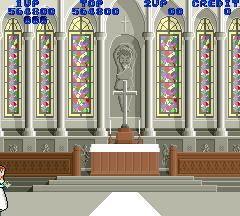
Aww, isn't this romantic? Momoko's all growed up and married, although she seems to be pretty quick to want kids.
Regardless of how you get here, be it on time, out of time, or ushered by aliens, a happy ending is had by all, isn't it?
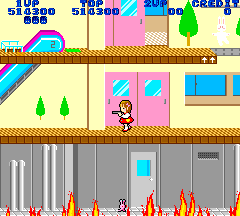
Or is it?!
Despite the game having an ending cinema, you don't stop playing, and the game starts over again. Just like how in Donkey Kong, after you save Pauline, you get to do it all over again. Unlike Donkey Kong, Momoko 120% doesn't get any more difficult on the second loop- the enemies don't seem to be any more aggressive or numerous, and you could say it's actually a little easier the second time around. This is because you can use Weapons 9 and 10 on any stage, rather than just from Stage 4 onwards, assuming you've acquired them. Also, looping the game is the only way to see the sixth Bonus Stage. The game will continue to loop, I assume, for infinity, which is why you're not allowed to continue- what's the point of continuing if it never ends?
As such, losing all your lives gives you no chance for a reprieve, but it does give you a chance for HIGH SCORE TABLE TIME!!!
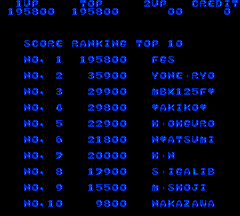
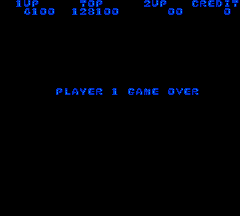
So, there's Momoko 120% for you, and whether this counts as a review or a guide, the game gets a thumbs-up from me. Maybe I'm just a bit odd, but there's something inherently satisfying about playing a game where a four-year old goes into a building armed with a handgun and then starts tearing shit up just because she can. Even before I decided to cover it here, I've sunk far too much time into such a short, weird little game, and I still haven't mastered it completely. It's got a pretty unique premise, the graphics are dangerously bright and colourful, and above all, it's curiously addictive, and fun to play. So, that's all the positive stuff out of the way...
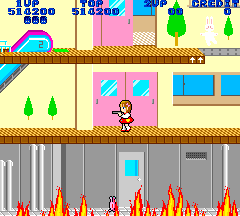
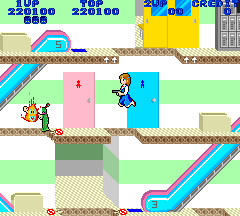
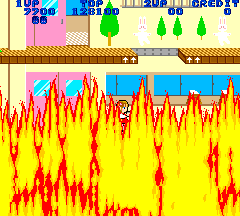
Unfortunately, Momoko 120% has a rather extensive array of programming oversights. Most of these are minor graphics glitches, such as enemies spawning in the basement where you can't hit them, the Power-Up Alien staying on screen after it's dead when you reach full power (although you can get rid of it by dying or entering a door), Momoko not burning to a crisp when the flames catch up with her, and stuff like that. It's relatively minor stuff that can be forgiven, and could well be emulation bugs caused by me abusing save states like they were going out of fashion while trying to find out what triggers the bonus stages- answer: dumb luck.
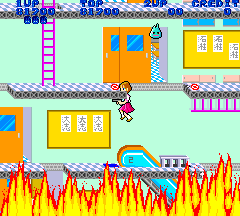
However, at least one of them happens on a real machine (it's not an emulation problem) and can really, really mess you up. Sometimes, for seemingly no reason, Momoko will either go down an escalator you're walking past (which, normally, shouldn't happen) or, even worse, she'll go down an invisible escalator, floating in the air as she does so, as you can see above. If you go down an escalator that's already there, then you can just go back up it again without losing too much time, but when it happens out of the blue, it can be disastrous, especially if the fire is right on your tail- it's an instant death. As far as I can tell, it's mostly caused by trying to go up an escalator with the diagonals rather than Up on its own. It's not 100% fool-proof, but the best way to avoid this is to stop and press Up to use an escalator- the game gives you a little bit of invincibility just as you're getting on and getting off an escalator, so stopping for a second won't kill you.
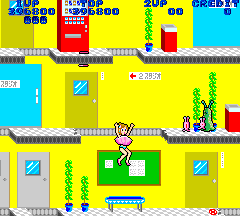
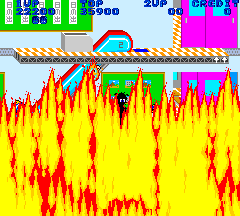
If there's any game out of all those I've covered here that's begging for a remake, it's this one. I'm serious, man, I'd do it myself if I could code anything more advanced than HTML. Fixing the escalator glitch would greatly help the game, and a few touch-ups here and there (I'm thinking mostly the order of the weapon upgrades, the general speed of the game, and maybe update the graphics) wouldn't hurt either. A real sprucing-up is what the game needs, you know what I'm saying? This isn't to say that Momoko 120% isn't a great game to begin with- it's simple and fun to play, and that's what matters the most in my book. It's almost like Contra meets Towering Inferno meets Hello Kitty. Look past the few warts here, and the cuteness of it all (I felt very silly while playing it, but remember- you play Bubble Bobble as well, admit it!) and you've got a charming little game that it wouldn't hurt to try out.
And now, it's that time, folks!
EXTENDED PLAY!
Momoko 120% - Unofficial Soundtrack
Momoko 120% - Unused Music
In a generous move that will almost certainly never be repeated for the sake of my sanity, I ripped the entire soundtrack of Momoko 120%. Why? Because, once again, the internet has failed me in the search for music from obscure video games. Hell, there's not much on this game at all, if I'm honest, much less the music. As a special bonus treat, the sound test contains a couple of unused tracks, including a strange version of Flight of the Bumblebee for some reason, and these are in a separate zip file. I got all of them except two- one was a worse-sounding version of another unused song, and the other was a completely surreal series of dings and dongs, separated by huge silences. It also seems to crash the sound test whenever I play it, so I left it out.
Aside from the music itself being ever-so-slightly catchy, if not a little grating after a while, there's another reason I ripped it for you wonderful people. Many sources (including the 'reliable' Wikipedia) state that Momoko 120% was originally a game based on the wildly popular Urusei Yatsura manga/anime series. Even if you didn't have the Famicom port (which we'll get to in a moment), the evidence for this is still in Momoko 120%- the music that plays throughout the entire game is the intro music to the Urusei Yatsura anime. They never took it out.
Classy, Jaleco. Classy. And to prove it, here's a quick comparison...
Momoko 120% - Main Theme
Urusei Yatsura - Lum no Love Song
Ha ha ha!
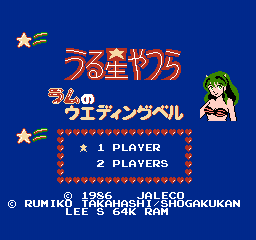
Of course, the other thing that proves Momoko 120% was supposed to be a Urusei Yatsura game is the Famicom home conversion.
Because it, uh, is an Urusei Yatsura game.
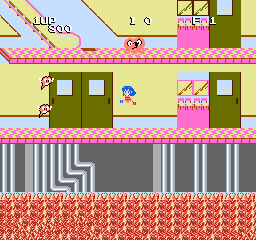
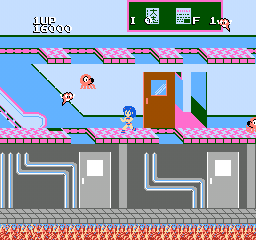
To give its full title, Urusei Yatsura - Lum no Wedding Bell is a Famicom conversion of Momoko 120% with a few changes here and there. Most importantly, Momoko's out, and Lum from Urusei Yatsura's in. Everyone's a winner, right? Well, everyone except you, because it's terrible. Lum no Wedding Bell is basically the same game, except that any and all redeeming qualities Momoko 120% had are gone. The bright pastel backgrounds of the arcade game are replaced by a colour scheme that makes Gears of War look vibrant and cheery in comparison, the functional controls are tossed out in favour of stiff jumping mechanics that make every leap a binding contract, and it's just dreadful.
According to a few guides I've read on the internet, Lum no Wedding Bell also adds in some extra stuff, like items that allow you to take a hit without dying, kill enemies in front of you automatically, invincibility, and stuff like that. There's also different bonus games. I'd love to share screenshots of these with you, but this game is really that bad that I can't stomach it for more than a level or two. It's the textbook example of how to fluff up the home port of a reasonably good arcade game. Don't play it.
So, were there any other home ports of Momoko 120%?
Well... Almost.
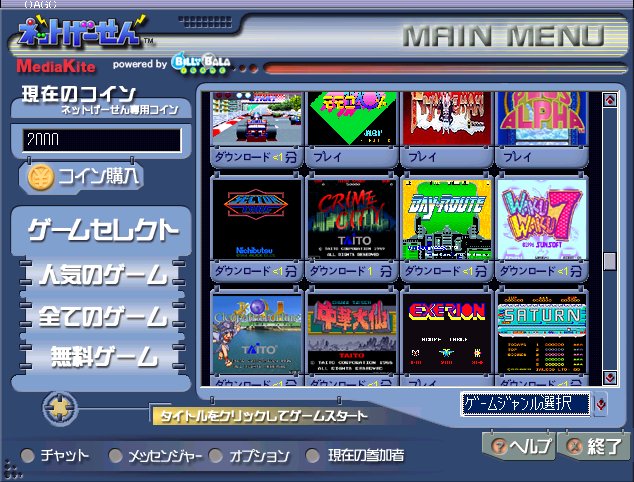
Around August of 2002, MediaKite announced Online Arcade Game Centre, a service for PCs that would allow you to play classic games from several different companies, like Data East, Sunsoft, and of course Jaleco, via the internet. Set to start with 54 titles on September 11th 2002, with 10 added every month, it would allow registered players to pay 500 Yen for 10 coins in each game, and also offer online co-op play! The full list of starting games can be found at the bottom of this page, and wouldn't you know it, Momoko 120% was one of the available titles. This would've been the game's first true home port that didn't suck!
And then it never happened. At least not in Japan.
Near the end of August in the same year, Mad Man's Café reported (via 2ch) that the service was to be indefinitely postponed in Japan- but seemingly it still ran in China- because the system behind OAGC, developed by Hong Kong's Billybala Holdings Co., had nicked its code from MAME! Not an isolated case- there's loads of multi-game arcade cabinets that pinch MAME's code for their guts, and the Oretachi Game Centre games on the PS2- re-releases of old arcade games like Haunted Castle and Sonic Wings- apparently stole MAME's code too (with poor results). Also, one of the .dlls in OAGC could potentially damage people's computers. Whoops. So, as far as I can tell, this system never got off the ground outside China. Ah, what could've been.
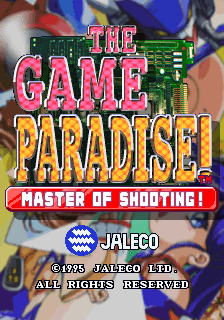
And now, for a brief look at the most bizarre video game cross-over of all time, Battletoads and Double Dragon notwithstanding. In 1995, Jaleco released The Game Paradise - Master of Shooting!/Game Tengoku in the arcades. Running on the MegaSystem 32 hardware, it's a very odd vertical shoot-em-up that's actually set within an arcade. Some bad guy is, uh, doing things, and as one of five ultra-famous Jaleco characters, you have to stop him. In addition to being set in an arcade, there's lots of video game culture references within, such as your enemies being cocktail cabinets, circuit boards, and there's a lot of strangeness around, such as the level where the 32-bit processor is kidnapped by the 8-bit processor, leading to a section that pits you against a slew of old-school pixel enemies.
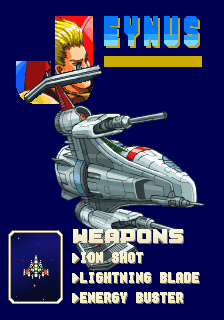
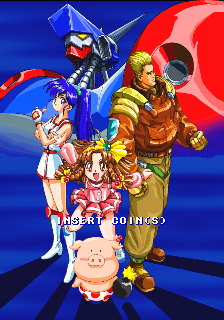
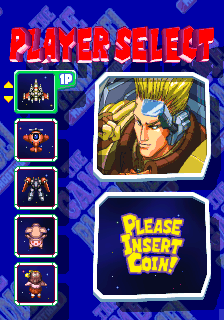
Oh, and when I said ultra-famous Jaleco characters? I lied. They aren't famous... At least, not to normal people. From top to bottom, there's the ship from 1983's Exerion, Selia and her bi-plane from 1989's Plus Alpha, Z-Dyne Mk. II from 1984's Formation Z, a pig from 1987's Butasan (which was brought to the UK for the Speccy/C64 under the hilarious name Psycho Pigs UXB), and, of course, Momoko from Momoko 120%. Naturally, each character has their own attributes, ranging from the normal (Momoko's shot is accompanied by little stars that home in on enemies) to the bizarre (the pig from Butasan throws bombs).
(Incidentally, the character selection is rubbish. Where's the car from City Connection? The dude from Ninja JaJaMaru-Kun? Rick and Allen from 64th Street: A Detective Story? Blanche from CyBattler? Suchie-Pai? Hell, I'd even let them get away with the Eater from Chimera Beast if they were going to be really audacious. Lame. On the plus side, I spotted a few cameos here and there, such as a bunch of characters from Rod-Land and an Arm Champs II cabinet. But seriously, where's the car from City Connection, God dammit?! You know, aside from in the sequel.)
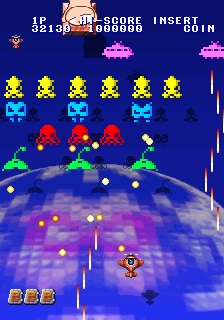
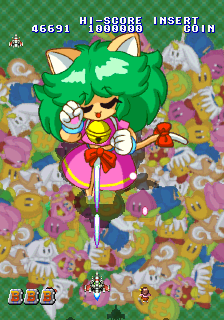
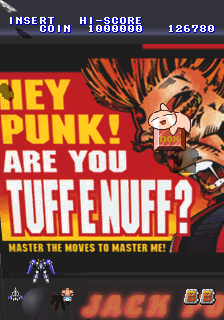
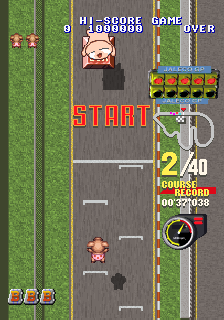
There's really not much I can say about The Game Paradise, outside of Momoko's appearance. I've sunk a bit of time into it, and it's alright, but it comes across as a average vertical shooter with the silly stylings of Parodius. I dunno, maybe I'm doing it wrong, but it just doesn't grab me at all. The power-up system isn't that interesting, although it's certainly odd- you pick up little 'options' of the other playable characters, who follow your character and use their standard shot. There's also a lot of video game-centric jokes, most of which require a fair understanding of video game history to 'get' (in particular, the stage where you're attacked by people sat in giant spinning machines with the label '180' on them- an amusing parody of Sega's R-360 cabinet) and maybe the game's just a little too wacky for it's own good. Even I have limits for silliness.
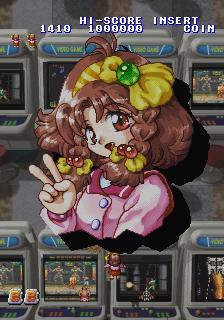
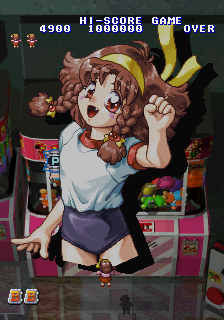
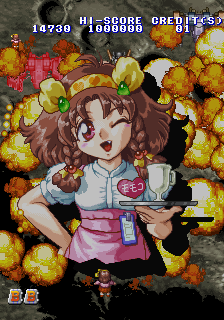
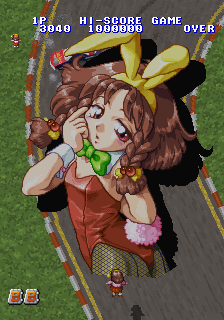
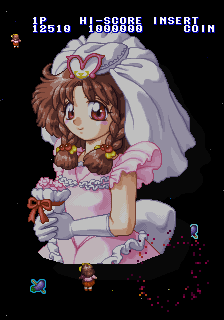
As for Momoko's appearance in this one, well, it's kinda aaaahh. For starters, her appearance seems to be based mostly on her look in the arcade game when she's 4, which I suppose is fair enough- it's her most recognisable form, after all (although clearer in the Saturn port, you can just about see that Momoko's original white t-shirt is under her new costume). What isn't fair enough are the vaguely fan-servicey pictures that show up whenever Momoko uses a bomb. As you can see above. C'mon, a wedding dress? Really? Is that what we're going for here? Well, I certainly hope you punks have fun looking at these screenshots, 'cause I didn't have fun taking them. You're welcome, internet.
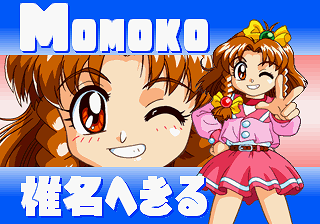
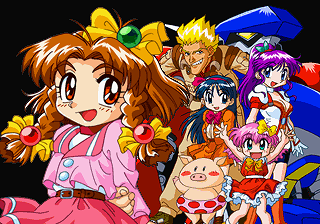
Luckily, they seem to have sorted the artwork out for the 1997 Sega Saturn version's intro, if not in the game itself- it's actually more cringeworthy as it adds schoolgirl and nurse costumes to her bomb repertoire. Siiiiigh. I've sunk a bit of time into the Saturn version, and again, it's alright- as well as the original arcade version, you also get an Arrange mode that adds the bizarre UFO/tank thing from Field Combat to the player roster (which has a very unique firing system- you must get enemies in its targeting reticle or get your soldier buddies to kill 'em) and a few more stages (including the now-famous karaoke stage where a terrible singer's words try to kill you, and an RPG-based stage).
It's also got some fully-voiced cut-scenes which mostly consist of the characters standing perfectly still while their mouths move, and they were really pushing this whole 'it's got voices!' thing as there was a limited edition that came with a VHS tape containing interviews with the voice cast and a completely bonkers cartoon that serves as an intro to the story. I do not understand any of it. From what I can gather, the pig speaks like Barry White, Momoko's cooking nearly kills several people, and the car from City Connection continues to not show up. I mostly skipped through it with the sound turned down low. Probably best you skip it, but it might be of interest to Jaleco aficionados.
![No, I'm not sure what the bunny girl is doing in the background either. I'm beginning to regret covering this at all, what if my wife sees all these Japanese girls on my page?!
[I'm sure you meant to type 'Waifu' back there. - Ed]
Oi! Watch it!](images/momoko120gpsakura.jpg)
For whatever reason, Momoko doesn't appear in the Playstation-exclusive sequel, GUNbare! Game Tengoku 2. According to the Japanese Wikipedia page for the game, she's replaced by Sakura, her sister, which is why she looks almost exactly the same, even wearing Momoko's t-shirt, but with purple hair and leg-warmers, as if she's a time-traveller from the 80s. Also, I think she's a vampire. Again, I watched the intro to this with the sound off, skimming through, desperately trying to find the car from City Connection (which actually is in this version, as our City Connection page will confirm, but I missed it because the driver and car design are totally different). Apparently, this particular game allows Player 2 to join in and help... With a light-gun. Hence the title. Aside from that, it uses ugly PS1-era 3D graphics, but seems to be much the same as the original.
And that's it. Momoko has never appeared in any other games (and let me tell you I am not playing through Jaleco's back-catalogue to make sure. This would involve playing through 64th Street: A Detective Story, and I just don't hate myself that much) and, unless the arcade game gets re-released on the new Virtual Console Arcade service (if Kunckleheads and Cyber-Sled can get on there, then anything's possible) then I dare say we've seen the last of the poor tyke. Oh dear, how sad, never mind.
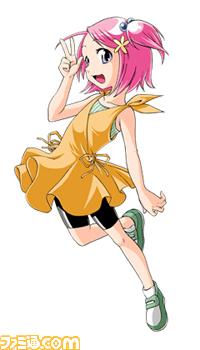
... Wait, hang on. We're not done yet.
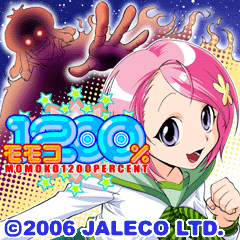
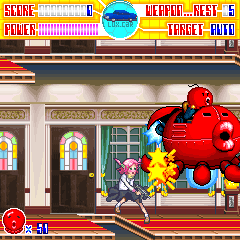
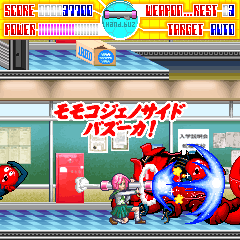
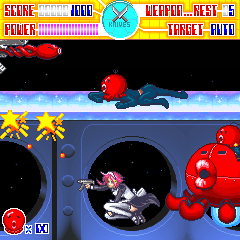
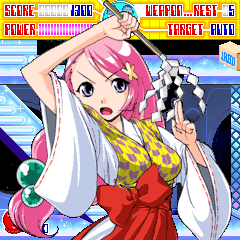
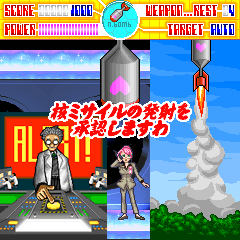
From this forum thread (near the bottom, after the link to this page aw yeah finally hittin' the big time) I was alerted to the fact that i-mode mobile phone sequels to Momoko 120% exist. Of course! How silly of me to not think there'd be any. After all, Jaleco made sequels to Plus Alpha and City Connection on phones, so I shouldn't be surprised. Anyway, as that thread states, there's four of them that are known. With that thread's help, we've found all we can, maybe there's more? We'll never know unless someone tells us!
For now, though, let's deal with what we've got. The first two were Momoko 1200% Parts I and II, released in 2006, available on the FOMA900 service (and, many years later, on the Playstation Vita via Playstation Mobile, until the service was shut down) and shown above- Part I on the top row, Part II on the bottom (shots taken from this archive of Jaleco's website). Without playing it, you can immediately tell that the Momoko we know has been replaced by some pink-haired girl (I'm noticing a pattern here), but she still has the same problem- aliens. What you can't tell from these screenshots is that the game is incredibly, punishingly slow- the game is now a seek-and-destroy where you have to find fifty (yes that's 50) martian soldiers and destroy them (three hits apiece) across stages that vaguely resemble the original (so, elevators, trampolines, that whole deal) and while you now have a gun that auto-rapid-fires and auto-locks-on and a special shot with limited uses and an overly-generous health bar, the whole game is so slow and dragged-out that it's not worth it. It's such a shame because there are some good ideas here- Momoko can run and slide, but it takes way too long to clear a stage. A real shame, but this is not even in City Connection Rocket's league.
You may be wondering, "If you've played it, where are the screenshots?". This is true, I'm still using the shots from Jaleco's website rather than shots taken from the Vita port, but the reason is pretty simple- I couldn't get through this one. I lasted two stages and I had to quit because there was no way it was getting better. And if you're booing right now and expecting more of Gaming Hell, then I shall tell you it took me an age to get through those two stages and then the game crashed and I decided that was enough of a sign for me to just stop. Forgive me.



As compensation, from Part I, here's some of Momoko's different costumes. Better than the ones from The Game Paradise, at least.
(These art pics were shamelessly nicked from Famitsu, of course. Some from Part II here.)
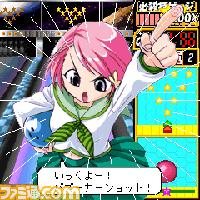
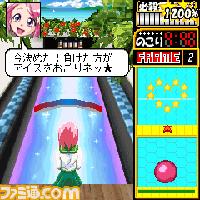
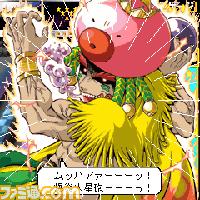
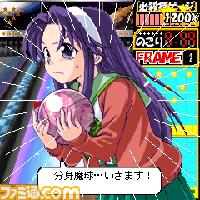
The next one is a bit stranger. I'm not sure if this was released in 2006 or 2007 (I've seen both dates given) but apparently the name is Momoko Mars Bowling (slightly more accurate than the other machine-translation I got, Mars Bowling - La Mars Cup of Momoko) and it's a bowling game that stars the new Momoko, her classmate, and who I'm guessing is the main villain of the Momoko 1200% games- you can see him on the title screen for Momoko 1200% Part I. I guess he's the Mars of the title? Beyond that, I can't tell you anything. Oh, and we nicked the screenshots from Famitsu, again.
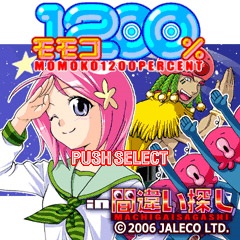
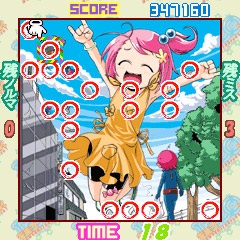
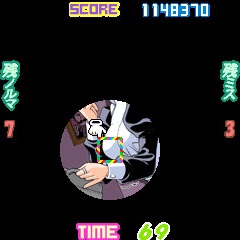
![[You're mistaken, of course, but your heart's in the right place. - Ed]](images/momoko120spot3.jpg)
We had to dig slightly harder for the other one, but here it is- with images purloined from K-Tai/Mobile Phone Watch, it's... Well, we think this one's called Momoko 1200% in Spot the Difference, released in 2006. We're going to guess it shows you a picture, then asks you to spot the differences. As you do. A bit like Magical Error wo Sakaze, then (except not). I'm not sure what else to type here, except perhaps this new Momoko could probably pass as the third, lost Kawaiikochan.
If you know any other details about these games, or the ones we've missed, do email us. It's on the front page.
And finally... Another adventure in site referral tracking.
Someone linked to this Momoko 120% article on a user page on the Pineight wiki hypothesising a connection between Momoko 120% and Donkey Kong.
I am presenting this without comment, except I'm pretty sure the dude behind the cross in the ending is Jesus. Not whatever a Selkie is.
Was it a guide, or was it a review? You don't know! It's over anyway, now, so return from whence you came!
I'm going back to the index to read the Zombie Raid review, to wash away all the cuteness.
... Oh, and for what it's worth, about a month after I started writing this article, Retro Gamer not only covered the arcade game, but they also ripped Lum no Wedding Bell to shreds as well. One of these days, I swear, I'll actually be on time with these bloody things.































![No, I'm not sure what the bunny girl is doing in the background either. I'm beginning to regret covering this at all, what if my wife sees all these Japanese girls on my page?!
[I'm sure you meant to type 'Waifu' back there. - Ed]
Oi! Watch it!](images/momoko120gpsakura.jpg)

















![[You're mistaken, of course, but your heart's in the right place. - Ed]](images/momoko120spot3.jpg)